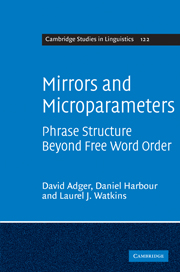Book contents
- Frontmatter
- Contents
- List of tables
- Acknowledgements
- Abbreviations and notation
- Kiowa phonemes and orthography
- 1 Introduction
- 2 Nonconfigurationality and polysynthesis
- 3 The clausal spine
- 4 Making mirrors
- 5 Interface properties of clausal domains
- 6 Anti-quantification and the syntax–semantics interface
- 7 Conclusion
- Appendix
- References
- Index
6 - Anti-quantification and the syntax–semantics interface
Published online by Cambridge University Press: 26 January 2010
- Frontmatter
- Contents
- List of tables
- Acknowledgements
- Abbreviations and notation
- Kiowa phonemes and orthography
- 1 Introduction
- 2 Nonconfigurationality and polysynthesis
- 3 The clausal spine
- 4 Making mirrors
- 5 Interface properties of clausal domains
- 6 Anti-quantification and the syntax–semantics interface
- 7 Conclusion
- Appendix
- References
- Index
Summary
Introduction
In the last chapter, we outlined a generalization about the kinds of elements that can appear in various clausal positions: focus-marked elements, bare quantifiers and wh-phrases are unacceptable when in pre-wh-position and in postverbal position. While this is perhaps unsurprising for wh-elements, which obligatorily move to CP in Kiowa, no such explanation is forthcoming for focus-marked elements and bare quantifiers. These are not required to move to any specific position, and so it is unclear why they should be unacceptable in the postverbal domain or the pre-wh-domain.
A further challenge arises from our having demonstrated that DPs in the postverbal domain are in their Merged base position; this does not initially seem plausible for DPs in the pre-wh domain, which are separated from their argument structure by (at least) the wh-element, which we know has moved. Given this, we need to explain why the same kinds of restriction apply to elements in such syntactically distinct regions of clause structure.
In this chapter, we lay out an explanation for these effects, which is connected to Rizzi's (1997) explanation for the impossibility of quantifiers in Clitic Left Dislocation constructions, but which develops the ideas in a slightly different way. The core of the analysis lies in the kinds of syntactic structure that must be delivered to the interface in order for quantificational elements to have an appropriate interpretation. We look first at focus marking in the postverbal domain, before turning to the behaviour of quantifiers in the same position and the question of why bare quantifiers behave differently from quantifiers with an NP restriction.
Information
- Type
- Chapter
- Information
- Mirrors and MicroparametersPhrase Structure beyond Free Word Order, pp. 153 - 175Publisher: Cambridge University PressPrint publication year: 2009
